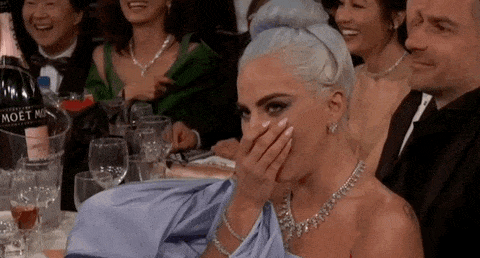This article is part of our body language guide. Click here for more.
Do you know how to read people and decode body language? It is one of the most essential people skills.
When you think about reading people, you need to understand how to group each body language cue into one of two buckets: a micropositive or a micronegative.
A micropositive signals interest, curiosity, or engagement.
A micronegative signals nervousness, disinterest, or boredom.
In an interaction you want to see more micropositives than micronegatives. Every nonverbal cue you read is about deciding whether it is a micropositive or a micronegative. Here are 7 powerful body language cues you should know how to read in people:
Spotting Shame
There is a universal behavior humans do when they feel ashamed or embarrassed, and it’s super easy to spot. When people get embarrassed, they often touch the side of their forehead. (See video above for a demo.)
This is a micronegative. You see this all the time when people are embarrassed. Even animators recognize this as the universal shame gesture.

Why does this happen? It is actually a starter gesture for wanting to hide or cover up or block out what is happening. If someone is really embarrassed, the forehead touch turns into a full-on eye block, where they go from the forehead touch to the eye cover.
Body Language Tip for You: Watch out for any time someone touches the side of their forehead or blocks their eyes. It likely means they are a little ashamed or embarrassed, and it might be time to back off.
Want to learn all 96 cues humans send to each other? Check out the latest comprehensive book on body language:
Unlock the Secrets of Charisma
Control and leverage the tiny signals you’re sending – from your stance and facial expressions to your word choice and vocal tone – to improve your personal and professional relationships.

Blocking
Whenever someone feels disengaged, uncomfortable, or closed off, their body shows it with what’s called blocking behavior. This is a micronegative.
Blocking is when we cover or block a part of our body as a barrier between us and someone else.
We do this subconsciously because we are trying to protect ourselves. Pay attention if someone suddenly crosses their arms, their legs, or frequently holds something—such as or a computer or a notepad or a pillow—in front of themself.
I found the most cringeworthy example of this in an old Blind Dating episode that went terribly wrong. I have to show you their first impression. Notice any blocking behavior in this video?
Did you see how she crossed her arms and legs right from the start? Doesn’t bode well for a good date…and it didn’t end well.
Body Language Tip for You: Watch for someone who does a lot of blocking. They might not be so open to you.
The Head Tilt
Do you hear that? It is a natural human behavior to tilt our head and expose our ear when we want to hear something better. This one is a micropositive!
If someone’s head tilts while the person is speaking with you, it is a great sign. It means they are listening, they are engaged, and they want to hear more. You know who is great at this? The ultimate great listener, Oprah Winfrey. I think one of the ways Oprah gets people to open up to her is with her amazing nonverbal. Let’s watch this clip and see how she listens with her body.
Did you see her slight head tilts and the slight nods? The head tilt plus nod is one of the most powerful nonverbal micropositives to show someone you really are listening.
Body Language Tip for You: If someone tilts and nods while you speak — keep them around. They like listening to you. Want to show someone you are listening? Give them the head tilt and nod.
Mouth Block
Have you ever seen a little kid tell a lie?

They frequently tell their lie, and then cover their own mouth. Subconsciously, whenever we are trying to keep something in, we cover our own mouth. As if to say to our brain, “No, don’t say it!”
The mouth cover is also a common thing to do when we are feeling embarrassed. Lady Gaga does it.

Howie Mandel does it.

Even Sharon Osbourne does it.
Body Language Tip for You: Watch for a sudden mouth cover. They might be trying to keep something from you.
Hands
Hands tell us so much about what a person is thinking. In fact, I could show you all of these clips on silent, and you know what the person is saying, without even hearing the corresponding words. Such as:
What you talking about?
Loooooove you!
Look at my face! Look at my face!

We always watch someone’s hands as they are talking. You should be using more hand gestures. They are a great micropositive because they help keep people engaged.
Body Language Tip for You: Learn all 20 hand gestures you should be using to get your message across. And watch this tutorial on hand gestures:
The Eyebrow Raise
When talking about body language, we hear a lot about eye contact — and that’s important. But you know what often is forgotten? The eyebrows. Eyebrows are a great little nonverbal secret. Here’s what you want to look out for, the eyebrow raise. This is a great micropositive!
Whenever someone is interested, engaged, or curious, they raise their eyebrows. It’s almost as if we want our eyebrows to get out of the way so we can see something more clearly.
Body Language Tip for You: Raise your eyebrows when you are interested, and don’t miss an eyebrow raise that is sent to you!
Facial Expressions
The last cue is the most important: It’s knowing how to decode the face. Facial expressions can be both micropositives and micronegatives, depending on which one you see.
Reading facial expressions is a game changer for accurately reading people. Dr. Paul Ekman discovered 7 universal microexpressions. The ones you want to look out for are:
- Fear
- Happiness
- Contempt
- Surprise
- Sadness
- Disgust
Crack The Code on Facial Expressions
The human face is constantly sending signals, and we use it to understand the person’s intentions when we speak to them.
In Decode, we dive deep into these microexpressions to teach you how to instantly pick up on them and understand the meaning behind what is said to you.
Don’t spend another day living in the dark.
Bonus Cue: Lie Detection
Lie detection is an incredibly powerful people skill to add to your arsenal. We have a 5 step method for spotting lies and bringing more truth into your relationships. In a ten-minute conversation, you are likely to be lied to two to three times. You might not even realize how often the people in your life are being deceitful. 91% of people lie regularly at home and at work. Check out our lie detection guide:
How to Tell if Someone is Lying
We also have a course:

I love all your ted talks & human behaviour conversations. They are amazingly true .Lots of lv to u vanessa ♥️
I love all your ted talks & human behaviour conversations. They are amazingly true .Lots of lv to u vanessa ♥️
I love all your ted talks & human behaviour conversations. They are amazingly true .Lots of lv to u vanessa ♥️
I love all your ted talks & human behaviour conversations. They are amazingly true .Lots of lv to u vanessa ♥️
I also love your talk it’s amazing .love is not for one person but it’s 4r 2
This will help me much in public presentation. Thank you!
I also love your talk it’s amazing .love is not for one person but it’s 4r 2
This will help me much in public presentation. Thank you!
I also love your talk it’s amazing .love is not for one person but it’s 4r 2
This will help me much in public presentation. Thank you!
I also love your talk it’s amazing .love is not for one person but it’s 4r 2
This will help me much in public presentation. Thank you!
Your talks and demos are very interesting and real. I enjoy these demos and the course is helping me a lot to understand humanity from another direction.
Your talks and demos are very interesting and real. I enjoy these demos and the course is helping me a lot to understand humanity from another direction.
Your talks and demos are very interesting and real. I enjoy these demos and the course is helping me a lot to understand humanity from another direction.
Your talks and demos are very interesting and real. I enjoy these demos and the course is helping me a lot to understand humanity from another direction.
Thanks this will really help me to understand people better.
Thanks this will really help me to understand people better.
Thanks this will really help me to understand people better.
Thanks this will really help me to understand people better.
Very educative, am currently in my first year in management and this information have gained I have observed it in my team members yet I was not able to decode. Now I can
Very educative, am currently in my first year in management and this information have gained I have observed it in my team members yet I was not able to decode. Now I can
Very educative, am currently in my first year in management and this information have gained I have observed it in my team members yet I was not able to decode. Now I can
Very educative, am currently in my first year in management and this information have gained I have observed it in my team members yet I was not able to decode. Now I can
I love this human behavior class thanks Vanessa
I love this human behavior class thanks Vanessa
I love this human behavior class thanks Vanessa
I love this human behavior class thanks Vanessa